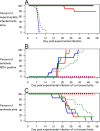Imperfect Vaccination Can Enhance the Transmission of Highly Virulent Pathogens
- PMID: 26214839
- PMCID: PMC4516275
- DOI: 10.1371/journal.pbio.1002198
Imperfect Vaccination Can Enhance the Transmission of Highly Virulent Pathogens
Abstract
Could some vaccines drive the evolution of more virulent pathogens? Conventional wisdom is that natural selection will remove highly lethal pathogens if host death greatly reduces transmission. Vaccines that keep hosts alive but still allow transmission could thus allow very virulent strains to circulate in a population. Here we show experimentally that immunization of chickens against Marek's disease virus enhances the fitness of more virulent strains, making it possible for hyperpathogenic strains to transmit. Immunity elicited by direct vaccination or by maternal vaccination prolongs host survival but does not prevent infection, viral replication or transmission, thus extending the infectious periods of strains otherwise too lethal to persist. Our data show that anti-disease vaccines that do not prevent transmission can create conditions that promote the emergence of pathogen strains that cause more severe disease in unvaccinated hosts.
Conflict of interest statement
The authors have declared that no competing interests exist.
Figures




Comment in
-
The Need for Evolutionarily Rational Disease Interventions: Vaccination Can Select for Higher Virulence.PLoS Biol. 2015 Aug 25;13(8):e1002236. doi: 10.1371/journal.pbio.1002236. eCollection 2015 Aug. PLoS Biol. 2015. PMID: 26305571 Free PMC article.
References
-
- Anon (2014) Antimicrobial resistance: global report on surveillance Geneva: WHO.
-
- Gandon S, Mackinnon MJ, Nee S, Read AF (2001) Imperfect vaccines and the evolution of pathogen virulence. Nature 414: 751–756. - PubMed
-
- Read AF, Mackinnon MJ (2008) Pathogen evolution in a vaccinated world In: Stearns SC, Koella J, editors. Evolution in Health and Disease 2nd ed. Oxford: Oxford University Press; pp. 139–152.
-
- Gandon S, Mackinnon MJ, Nee S, Read AF (2002) Antitoxin vaccines and pathogen virulence. Nature 417: 610. - PubMed
Publication types
MeSH terms
Substances
Associated data
Grants and funding
LinkOut - more resources
Full Text Sources
Other Literature Sources

